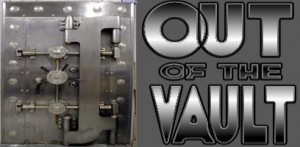
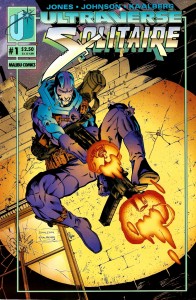 Having so much fun going through old Ultraverse titles that I’m going to keep pushing the streak. I first heard of Gerard Jones, co-writer of Prime and writer of this week’s title, when he was doing a series of very funny short stories titled “My Pal Superman” for one of the comics fan magazines (some of those stories are now posted on the web, but under the title, “My Pal Splendid Man,” with all DC characters changed to generic lookalikes). He had also written a small-press title in the 80’s that I quite liked, titled The Trouble With Girls.
Having so much fun going through old Ultraverse titles that I’m going to keep pushing the streak. I first heard of Gerard Jones, co-writer of Prime and writer of this week’s title, when he was doing a series of very funny short stories titled “My Pal Superman” for one of the comics fan magazines (some of those stories are now posted on the web, but under the title, “My Pal Splendid Man,” with all DC characters changed to generic lookalikes). He had also written a small-press title in the 80’s that I quite liked, titled The Trouble With Girls.
So it was strange to me that his work on Ultraverse had so little humor in it. Prime had a few laughs, but also a ton of melodrama. And this other comic he wrote, Solitaire, was downright dark.
Solitaire was a sort of cross between The Shadow and Shang Chi, Master of Kung Fu, with a little Wolverine thrown in. Nicholas Lone, the son of uber-gangster Anton Lone, has pledged to destroy his father’s criminal empire. To that end, he has assembled a network of spies and agents to serve as his eyes and ears on the mean streets of L.A. He battles gangsters and cultists and nuclear weapons dealers, all in a quest to bring down his father. Oh, and he’s got one more thing working in his favor…
His father has injected him with nanomachines which give him the ability to heal almost any wound. Handy.
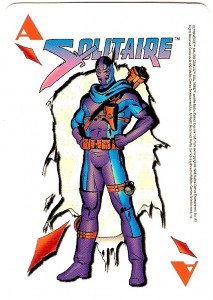 I liked Solitaire quite a bit. I thought the costume was striking (not loving the mismatched gloves and boots, but I like that weird collar frill he’s got going on, and the color scheme), I liked the art, and I liked the dark tone. And of all the crazy gimmicks Ultraverse pulled to drive up sales, I thought Solitaire had one of the coolest.
I liked Solitaire quite a bit. I thought the costume was striking (not loving the mismatched gloves and boots, but I like that weird collar frill he’s got going on, and the color scheme), I liked the art, and I liked the dark tone. And of all the crazy gimmicks Ultraverse pulled to drive up sales, I thought Solitaire had one of the coolest.
There were two separate gimmicks with issue one, although we wouldn’t know about the second one for several months. The first was the playing card at left which shipped with the first issue (yes, if you bought multiple issues, you could conceivably get all four suits of aces–at least, that’s what it says in the issue–I never bought a second copy to find out).
The second was the really cool one, though. The covers of the first five issues featured Solitaire in various action poses, really unrelated to the storyline in the issue, except that he fought in every one. But as the series built up to the climax of its first arc in issue six, the covers took on new meaning.
This was the gimmick. As issue five ends, Solitaire is on a rooftop about to assault his father’s stronghold. The cover of the first issue becomes the next frame of the storyline, as Solitaire begins his attack. You read the covers of the first six issues in sequence, and the first panel of page one of issue six is the panel immediately following the cover of issue six. It was really cool.
The art by Jeff Johnson and Barbara Kaalberg was good, too. Johnson’s work was solid, with good storytelling, good flow from panel to panel, and more than a nod to Kevin Maguire.
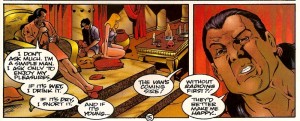
I also liked the way Johnson drew Solitaire’s mask as clinging to his face, giving Solitaire a range of expression most masked heroes didn’t have, plus a completely unique look.
The computer coloring in this book was more subtle than that done in Hardcase and Firearm, which really pushed the boundaries. I liked that, too. I never felt that the art was being overwhelmed by the color.
Solitaire ended after 12 issues with the defeat of Anton Lone, and that both surprised and pleased me. Instead of the usual method of stretching out the ongoing conflict thanks to insane coincidences and improbable decisions and events, the storyline drove forward issue by issue and then ended. Solitaire as a character was promised to go on, but other than a one-shot flipbook appearance, I never saw him again. According to Wikipedia, he did play a small part in the Marvel iteration of the Ultraverse, but I was well out of it by then.

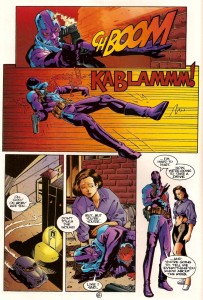
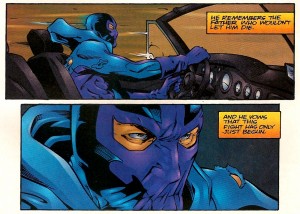



Just ran across this. Thanks for a trip down memory lane!
Thanks for stopping by. Always a pleasure to hear from the creators.